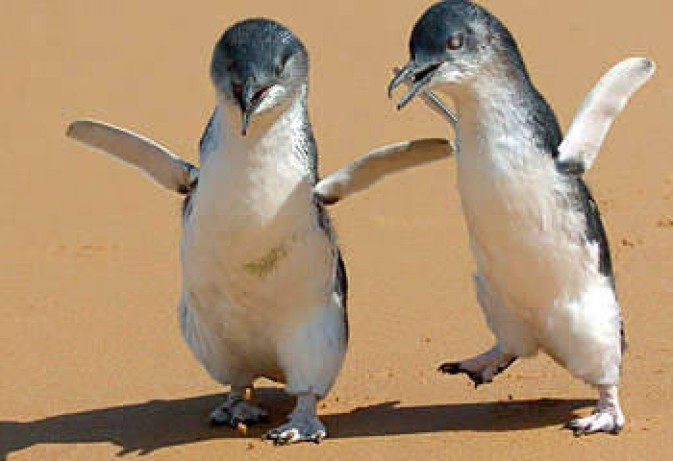George Miller's movie Happy Feet raises the consciousness of Australians about the lives of penguins in Sydney.
Happy Feet in Harbour.
Daily Telegraph. Tuesday December 12th. page 11.
Between raising chicks, avoiding predators and finding food, a city penguin's lot can be hectic.
But Sydney's penguins also have their share of fun, and their leisure time is a lot like that of many Sydneysiders – sunbaking on beaches in North Harbour or body surfing waves.
Once the sun starts to set though it's back to the business of bringing food home to the family.
Manly's little penguins, also known as fairy penguins, reside in Australia's only mainland colony, where they breed from about June to February.
During this time, their routine involves getting up before the sun and heading into the water to hunt.
First check is generally around Spit Bridge. Top tucker includes small baitfish like anchovies, pilchards, or squid. If they are breeding, only one of the parents leaves the nest.
"They take it in turns," Manly little penguin recovery team leader Tania Duratovic said.
If they have no luck in North or Middle Harbour, they usually headed towards the Opera House for lunch.
Along the way, she said they might stop at beaches to sunbake – warming up after being chilled by the water. Beaches are also a safe haven from the their main predators, sharks.
Even though about 80 penguins are in the Manly colony, they are usually found swimming and hunting by themselves or in small groups.
In breeding periods, they are not likely to travel more than 6km from the nest but on an average day would swim about 15km.
"Travelling at a leisurely pace they will do 5km/h but they can get up to 8.5km/h," Ms Duratovic said. An Olympic level 50m freestyle swimmer hits only about 8km/h.
Around sunset they return to the colony where they sit in large numbers about 100m off the beach.
"They call out to their mates on land to see if it's safe for them to come ashore and go straight into the burrows and feed the chicks," she said.
When the chicks are fed, the parents take time out for themselves when they groom each other. But they never go far from their nests.
The penguins usually swim in the Harbour but have been spotted as far away as Pearl Beach on the Central Coast, inland to Hunters Hill and south to Bondi in breeding season.
Most dive down to only 5m while hunting around Sydney but they can dive up to 30m. The deepest recorded dive was 65m at Victoria's Phillip Island.
"Surprisingly it's easier for them to swim under the surface than on the surface," Ms Duratovic said.
Between March and May when they are not breeding they can travel up 100km a day.
A Department of Environment and Conservation tagged penguin was recorded travelling from Manly to Phillip Island, Victoria, while another swam 1402km to Granite Island in South Australia.
They start to moult in January when they gorge themselves to double in size – to 2kg.
"By the end of it they look pretty appalling with old feathers hanging off them," Ms Duratovic said.
"We get reports from people thinking they are sick."
Ms Duratovic said a penguin's life maybe filled with routine but they are an adventurous and determined bird.
Frolic....it's not all fun as penguins spend a long day getting the food for their chicks.
Endless hunt for food
4.3Oam: During breeding season, Manly’s penguin colony wakes up before first light, fluffing their feathers and preening to make sure their oil which waterproofs them is spread evenly. Only one penguin of each breeding pair leaves in search of food
During the day: Feeding time. Penguins start hunting, searching for schools of small baiffish like whitebait and pilchards. They will often pick off fish from the edges of “baitballs” —tightly packed baitfish rounded up by larger predatory fish. They hunt from the Spit Bridge in Middle Harbour to the main Harbour, from the Bridge to North Head, or open ocean
Hunting can be hard work and in the day they may stop at nearby beaches for a nap, or to evade predators like sharks. Before returning to their nests they feed again to bring food to their families
7:30pm: In twilight they come back as a group, floating off the shore and “talking” to their mates. After about an hour they call to penguins ashore to see if it’s safe to come back in
8.3Opm-10.3Opm: They come ashore and begin feeding their young with regurgitated fish and squid. Then the pairs leave their young and head out for some quiet time, when they groom each other to re-affirm their breeding bonds
Midnight: Bed time
